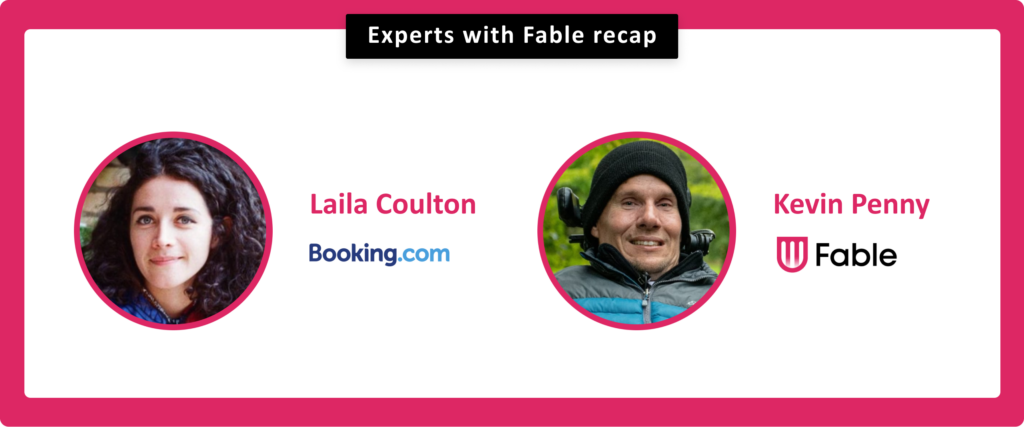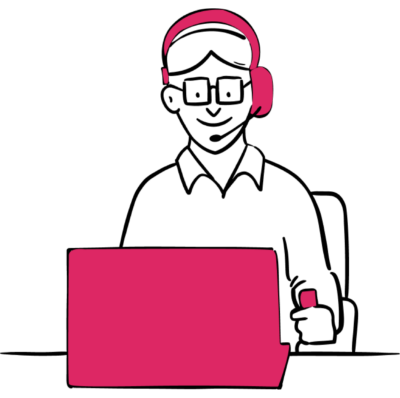
Experts with Fable recap
How Booking.com sparks cross-team collaboration through accessible and inclusive research practices
Experts with Fable is an ongoing webinar series where UX designers, researchers, product managers, engineers and accessibility professionals from leading companies discuss their digital accessibility projects, lessons, and strategies. To stay in the loop about future Experts with Fable, follow us on LinkedIn or sign up for our newsletter.
Fable’s recent survey of our community of testers who use assistive technology revealed that 80 percent of respondents experience some form of travel anxiety. Ensuring that travel websites are inclusive and accessible is one area that stress can be alleviate. Booking.com, one of the largest websites in the travel space, has been working hard to move the industry forward towards greater accessibility.
In our Experts with Fable session with Booking.com, Maya Alvarado, Senior Accessibility Researcher at Booking.com, and Kevin Penny, accessibility tester and a member of Fable’s community of assistive technology users discussed how collaboration happens on teams through accessible and inclusive research. The webinar was facilitated by Felipe Soares, Customer Success manager at Fable.
Planning the journey: how Booking.com got accessibility started
“I’ve done extensive traveling, and I’ve learned a lot over the past 20 years since I’ve started being an avid traveler. When people ask me for advice about trying to go on a vacation, the planning part is so important.” – Kevin Penny
If people with disabilities are going to have a successful and enjoyable trip, advanced preparation is critical. From making sure the plane or train is accessible, to ensuring the hotel has accessible rooms, to getting the assistance a person with a disability requires, creating a plan is the key.
Similarly, some planning and preparation before your organization begins its accessibility journey can be an important factor in ensuring its success.
Getting the lay of the land: understanding the current state of accessibility
“Our senior director of user experience Research at the time joined the task force as a collaborator. So as an equal, she brought her experience in accessibility, but also her support as a leader. It was really meaningful, and I think helped us to grow that practice.” – Maya Alvarado
The accessibility team at Booking.com was originally formed in 2019 to resolve accessibility issues centrally and enable the business to comply with international accessibility legal guidelines and requirements. However, researchers quickly realized that there was a lot more they needed to do to create inclusive and accessible experiences.
The first approach involved creating a small task force of interested stakeholders, who worked together to document the existing accessibility research that had been done, identify the gaps, and determine the way to start. One of the things that made this effort successful was the participation of the Senior Director of User Experience Research at Booking.com, ensuring that the task force had buy-in from high-level leadership.
Exploring and learning: getting the wider accessibility picture
“The talks were educational and inspirational, and we were able to learn what we could do in our own setting.” – Maya Alvarado
Next, they brought in industry experts to give a series of accessibility related talks to the organization. By working with industry leaders from Google, Inclusively, Scope, and others, they were able to both teach and inspire employees to work on accessibility. Familiarizing employees with not just the legal requirements but giving them the wider industry picture of how and why accessibility matters, brings everyone onto the same page and allows them to see the impact of accessibility work on all users.
The first steps: exploratory accessibility projects
“In this mobile lab, which involved some research and some brainstorming on what we could action, we found that there were significant barriers for users when trying to pick a date in the calendar.” – Maya Alvarado
In accessibility, as with any other major effort, you must walk before you can run. To stretch the new accessibility research muscle Booking.com was building, they began with small side-projects that they could do in conjunction with the projects they were already working on. They launched a small exploratory project in partnership with other organizations, to learn the experiences that users with visual impairments were having booking a trip within the Booking.com mobile app.
Bringing others along on the trip: accessibility training for entire teams
“We had a goal for all researchers to be trained in accessibility. And we successfully trained 100% of researchers in accessible and inclusive research practices. This is with the mindset that research comes so early in the product development journey that we’re able to be translators of issues. What we’re hearing in the market, what we’re hearing directly from our travelers, and include that in the product development.” – Maya Alvarado
With some small and successful projects under their belt, Booking.com committed further resources to accessibility to expand their research efforts. The first step was to invest in training the entire team, empowering all the researchers at the company to conduct accessible and inclusive research, and distributing accessibility knowledge organization wide. If accessibility is going to be an ongoing goal of any organization, it must ensure that everyone has the learning, tools, and resources they need to achieve the target.
If you’d like to learn more about the accessibility journey at Booking.com, Maya published an excellent article that goes into more detail on how they built out their practice.
The three strands of Booking.com’s accessibility research practice
“Accessibility research is just user research that’s more inclusive of disabled people and designed with their needs in mind.” – Maya Alvarado
Booking.com’s accessibility and inclusive research takes place in three key areas, touching every aspect of product development:
- Digital accessibility: can a broad range of users access the basic components with the assistive technology the use?
- UX accessibility: once the basic individual components work with assistive technology, are the end-to-end flows accessible? Once all the components are put together into a user journey, what is that experience like?
- Inclusive service design: have the needs of all users been met, not just on the website, but through the entire travel process?
If you’d like to learn more about what goes into an individual research session with an assistive technology user, Fable hosted a webinar going into more detail on the topic: Unlocking the power of accessibility research.
Traveling together: distributing accessibility
“We all need collaboration to achieve accessibility. It’s something we’re not going to achieve by working in silos.” – Maya Alvarado
In accessibility research, meaningful impact can only be achieved with cross-team and cross-functional collaboration. For Booking.com, this collaboration happens in three ways:
- Collaboration with people with disabilities: Booking.com uses Fable to get proposed designs and solutions in front of people with disabilities quickly, collecting data about what works and what doesn’t and draw conclusions that center the actual needs of assistive technology users in every decision.
- Collaboration between accessibility, UX research, and tech: to act on any findings, and move the needle on accessibility, UX researchers, accessibility experts, and the product team all collaborate to support and learn from one another to solve challenges and implement change.
- Collaboration with the wider business: travel is about more than just booking a hotel or a flight. Accessibility researchers at Booking.com collaborate with the wider business to understand the travel needs of people with disabilities throughout the journey, to understand how Booking.com can improve the entire origin-to-destination travel experience.
Accessibility advice for other organizations
“It was difficult for one accessibility team to support the whole company and the issues across that whole product. And so really growing the skills for others and embedding accessibility within each product team was key for us.” – Maya Alvarado
Based on her work at Booking.com, Maya has several pieces of advice for other organizations looking to expand their accessibility efforts:
Define roles and responsibilities
For everyone to contribute, it’s important that each person and team knows what their accessibility responsibilities are, and has the tools and processes to achieve them
Open office hours
The accessibility team has UX and tech open hours, where anyone at the company can come to get accessibility feedback on their work. This helps to remove silos and promote inter-team collaboration and discussion of accessibility.
Host events
Leading in-person accessibility events and workshops helps not only to train teams, but it also helps to socialize accessibility, inspire everyone to work on it, and get different parts of the organization collaborating with each other. These events work best when they involve showcasing the experiences that assistive technology users are having with your product.

